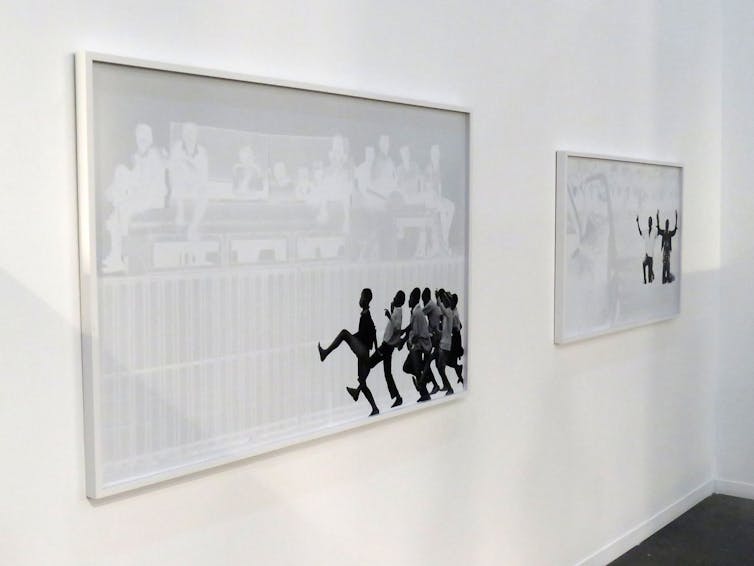 In an interview published in the New York Times, American visual artist Hank Willis Thomas describes his work as “collaborative storytelling”. He routinely uses archival images in his work, sometimes making only minor changes to the existing image. This method has sparked a controversy about whether his practice should instead be understood as appropriation.
In an interview published in the New York Times, American visual artist Hank Willis Thomas describes his work as “collaborative storytelling”. He routinely uses archival images in his work, sometimes making only minor changes to the existing image. This method has sparked a controversy about whether his practice should instead be understood as appropriation.
Thomas has produced a large body of work that focuses on South African history. Much of it draws directly on images taken by South African photographers. Graeme Williams iconic image, “South Africa, Thokoza Township, Johannesburg, 1991, Police watch an ANC rally while children taunt them by toyi-toying on the other side of the fence”, is at the centre of a storm provoked by Thomas’s decision to use it in an artwork.

Photo taken at the Joburg Art Fair of Hank Willis Thomas’s version of Williams’s colour original. Graeme Williams
Thomas’s piece was exhibited by the Goodman Gallery at the recent Joburg Art Fair and priced at USD$36 000. His “collaboration” with Williams took place without the photographer’s consent. He didn’t acknowledge the source of the image; nor did he intend to share the profits from the sale of the work.
For the most part artists and the art world scoff at the notion of responsibility, the need to ask permission, or any kinds of considerations that would delimit creative freedom.
However, Thomas is ostensibly a different kind of artist. His work has centred on issues of race and social justice. In 2016, he and Eric Gottesman founded For Freedoms, an artist-run super Political Action Committee. It has produced and installed 50 billboards in 50 states to contest the current political regime in the US.
Thomas is profoundly critical of extractive economies that take black people’s bodies and lives, using them for commercial gain without ever recognising them as individuals.
Much, if not most, of Thomas’s work is indebted to the photographers from whose archives he derives not only his inspiration, but also the raw material for his art. His failure to give proper credit comes off as arrogant and hypocritical.
The story of Ernest Cole
In the abstract, the collective work of photographers who produced the visual archive of life under apartheid could be understood as “collaborative storytelling”. But the photographs that constitute this archive were taken by individual photographers, many of whom remain unrecognised.
Ernest Cole is one example. He was born in 1940 in Eersterust, a township near Pretoria. In 1958, he joined the staff of Drum Magazine and went on to produce brilliant and painful photographs of life under apartheid.
In 1966, he went into exile and spent the next 20 years moving between the US and Europe, where he continued to work as a photographer. His book, House of Bondage (1967) was a landmark publication. It was the first book by a black South African photographer to document everyday life under apartheid.
The book contains almost 200 black and white photographs that Cole took in townships, city streets and mining compounds – and in prisons, where he used a hidden camera. One of Thomas’s most effective and chilling works is his sculptural rendition of Cole’s image of a long row of naked miners, their arms raised above their heads, photographed during a medical inspection at a mining compound.
Thomas’s reworking of the photograph shows only the heads and arms of the miners. The remainder of their bodies have been swallowed up by the white wall-like structure within which they are embedded. This work can be read as a critique of racial capitalism and of the ways in which black people’s bodies are consumed by the violence of white supremacy.
However, this and other readings of the work are possible only because I recognise the image it draws from, and to some degree replicates. Its power derives from the connection between the sculpture and the photograph.
It cannot be assumed that Cole’s photograph, which many people consider an iconic image of the structural violence of the apartheid state, will be recognised by everyone who views it. Nor will most viewers know where it was taken or who the photographer was, without a caption to provide this detail. It is even less likely to be recognised given that the photograph, which provides the conceptual ground for Thomas’s work, is effectively submerged within the sculpture.
As art historian Kerr Houston notes in his review of “History Doesn’t Laugh”, Thomas’s 2014 solo show at the Goodman Gallery,
His decision to focus on gestures apparently led him to jettison much of the rest of the original photographs – and the resulting loss is considerable. Cole’s photograph of the miners, for instance, pictures a row of papers that stand behind each man – and that implicitly complete their dehumanisation, converting them into mere data in the larger ledger of labour.
Thomas’s work, titled “Raise Up”, omits Cole’s original caption, “During group medical examination the nude men are herded through a string of doctor’s offices”. Cole himself was extremely anxious that his images be viewed in context; he preferred the photo essay form to the single image.
Racial capitalism
The debate about the right to make use of already existing images has drawn attention to the significance and value of South Africa’s photographic heritage.
It also casts light on just how difficult it is to critique globalised racial capitalism from within the art market, itself a system that serves to replicate the inequalities Thomas is seeking to contest through his work.
Acknowledging the source of the images he uses in his work more fully would amplify rather than diminish the power of Thomas’s political art. Understanding the context in which an image was made is critical for interpreting its significance. And, by engaging with the photographers, requesting permission to use of their work, and sharing the financial rewards and accolades this truly collaborative work would attract, artists like Thomas could begin the process of honouring South African photographers’ legacies.
Written by Kylie Thomas, Associate Researcher at the Institute for Reconciliation and Social Justice at the University of the Free State, University of the Free State
This article is republished from The Conversation under a Creative Commons license. Read the original article.
EMAIL THIS ARTICLE SAVE THIS ARTICLE ARTICLE ENQUIRY
To subscribe email subscriptions@creamermedia.co.za or click here
To advertise email advertising@creamermedia.co.za or click here











